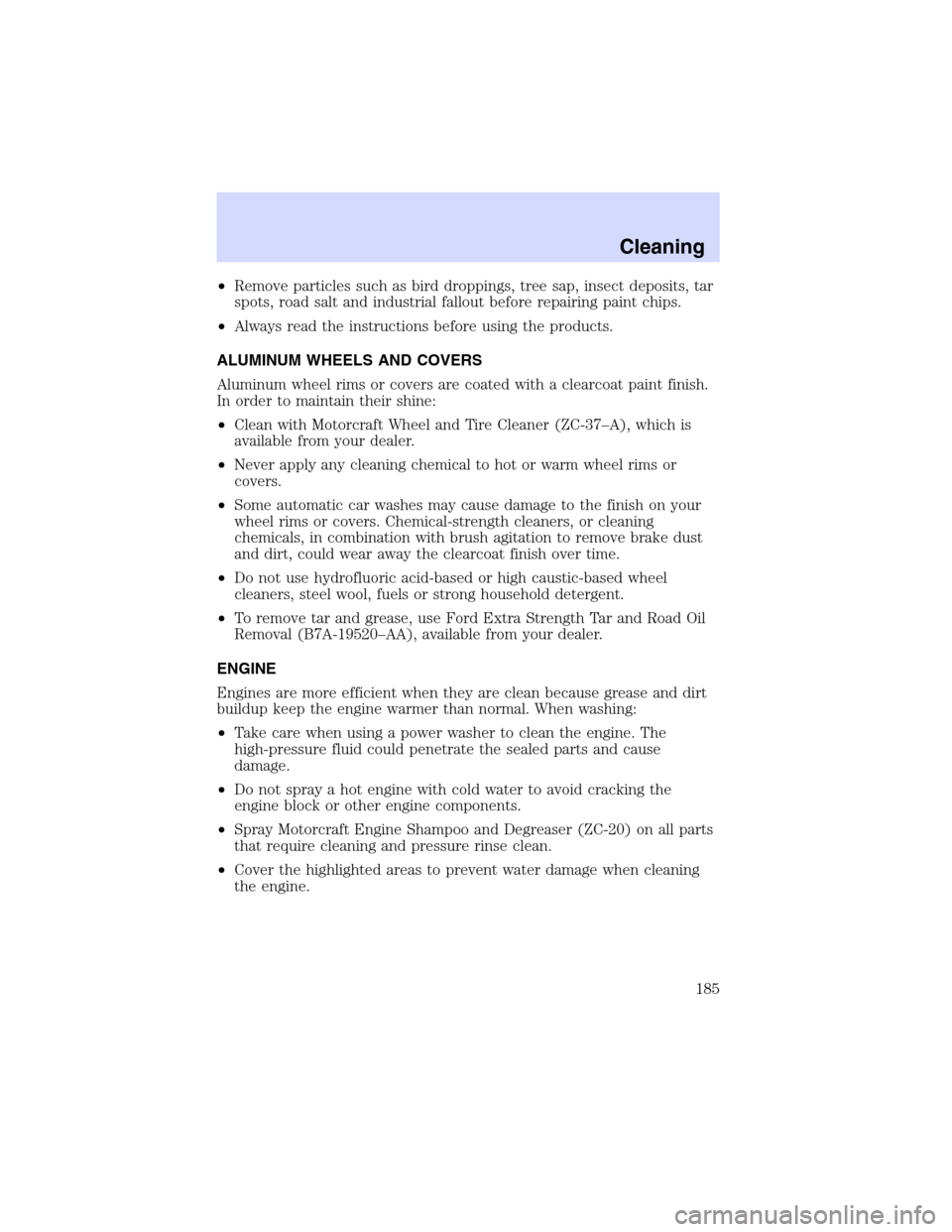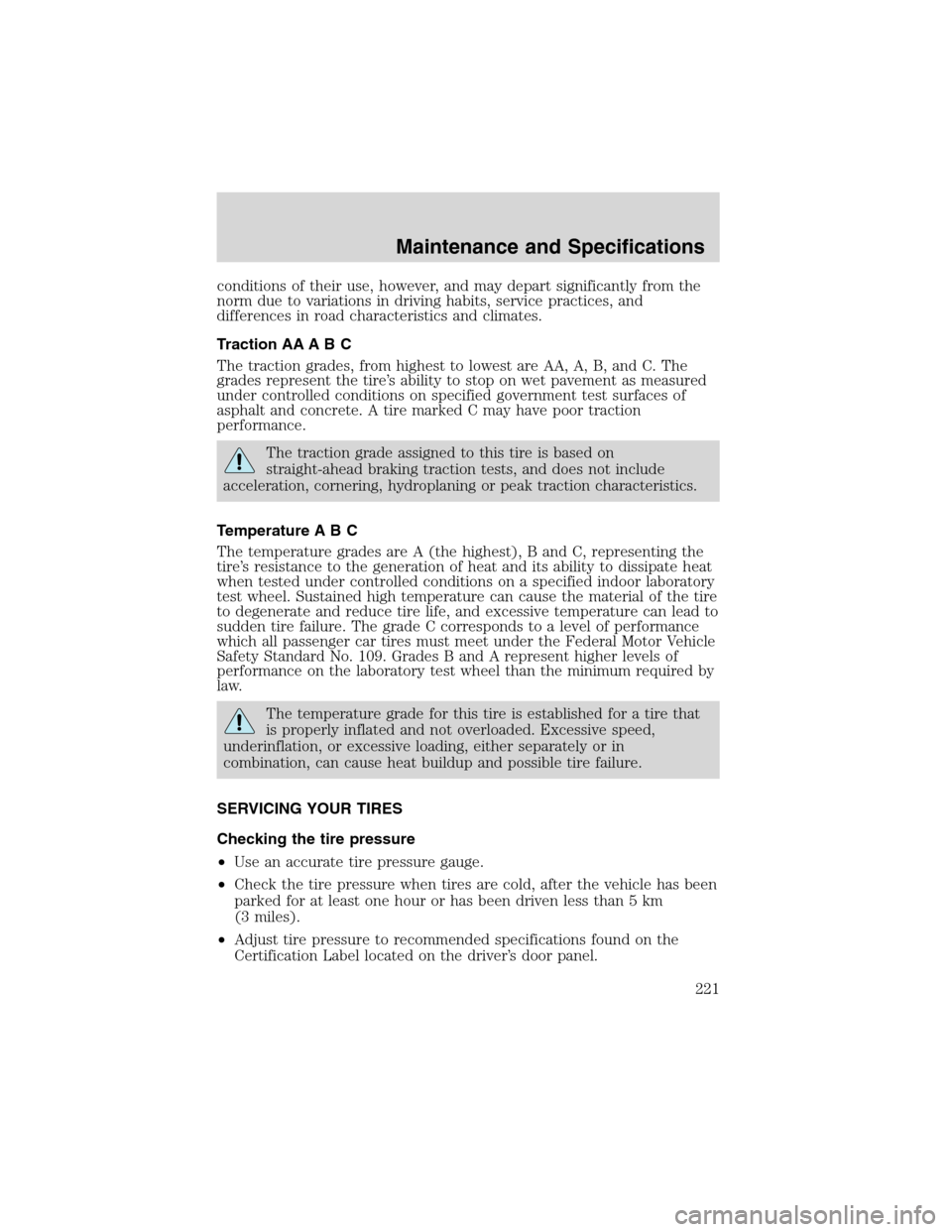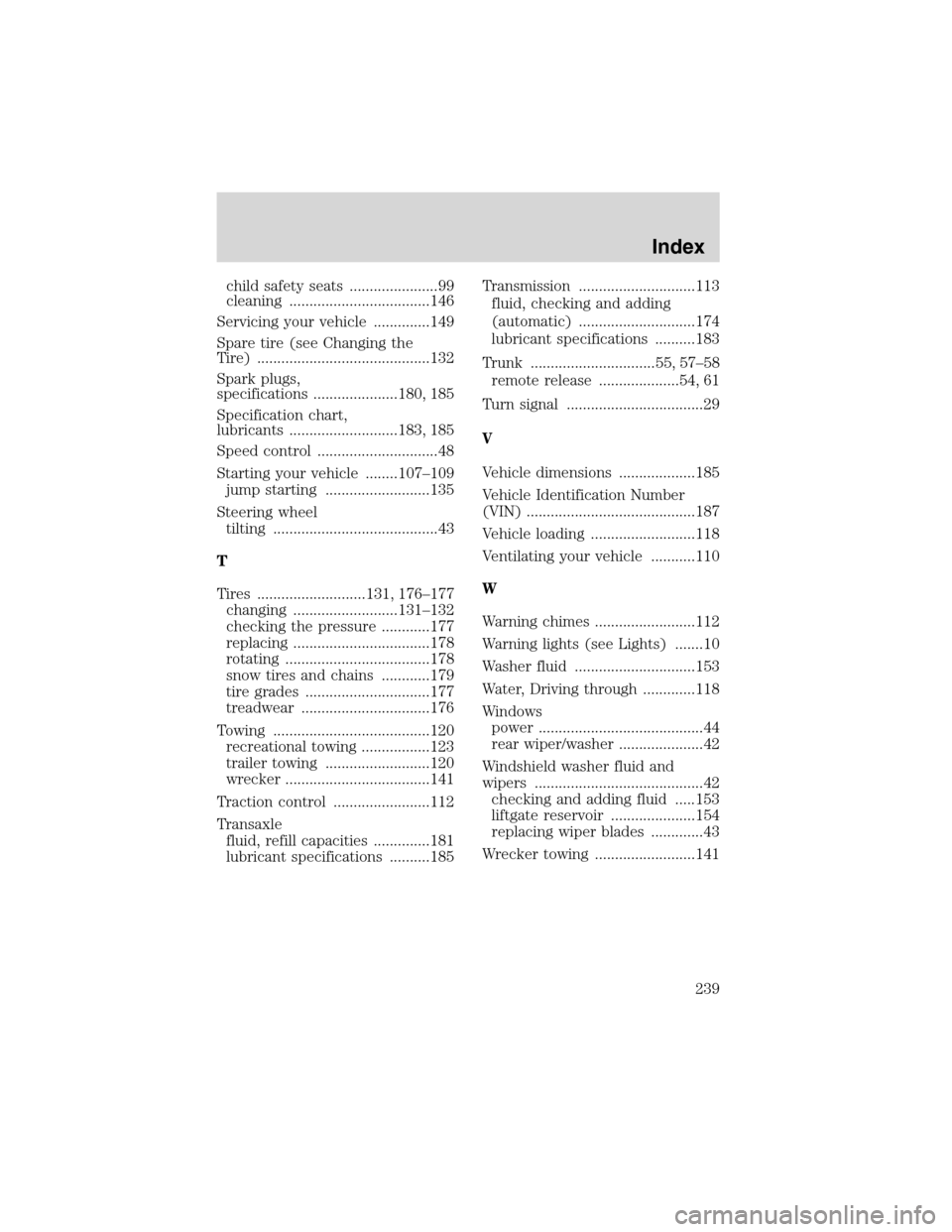tire pressure Mercury Sable 2002 Owner's Manuals
[x] Cancel search | Manufacturer: MERCURY, Model Year: 2002, Model line: Sable, Model: Mercury Sable 2002Pages: 240, PDF Size: 3.53 MB
Page 185 of 240

•Remove particles such as bird droppings, tree sap, insect deposits, tar
spots, road salt and industrial fallout before repairing paint chips.
•Always read the instructions before using the products.
ALUMINUM WHEELS AND COVERS
Aluminum wheel rims or covers are coated with a clearcoat paint finish.
In order to maintain their shine:
•Clean with Motorcraft Wheel and Tire Cleaner (ZC-37–A), which is
available from your dealer.
•Never apply any cleaning chemical to hot or warm wheel rims or
covers.
•Some automatic car washes may cause damage to the finish on your
wheel rims or covers. Chemical-strength cleaners, or cleaning
chemicals, in combination with brush agitation to remove brake dust
and dirt, could wear away the clearcoat finish over time.
•Do not use hydrofluoric acid-based or high caustic-based wheel
cleaners, steel wool, fuels or strong household detergent.
•To remove tar and grease, use Ford Extra Strength Tar and Road Oil
Removal (B7A-19520–AA), available from your dealer.
ENGINE
Engines are more efficient when they are clean because grease and dirt
buildup keep the engine warmer than normal. When washing:
•Take care when using a power washer to clean the engine. The
high-pressure fluid could penetrate the sealed parts and cause
damage.
•Do not spray a hot engine with cold water to avoid cracking the
engine block or other engine components.
•Spray Motorcraft Engine Shampoo and Degreaser (ZC-20) on all parts
that require cleaning and pressure rinse clean.
•Cover the highlighted areas to prevent water damage when cleaning
the engine.
Cleaning
185
Page 221 of 240

conditions of their use, however, and may depart significantly from the
norm due to variations in driving habits, service practices, and
differences in road characteristics and climates.
Traction AA A B C
The traction grades, from highest to lowest are AA, A, B, and C. The
grades represent the tire’s ability to stop on wet pavement as measured
under controlled conditions on specified government test surfaces of
asphalt and concrete. A tire marked C may have poor traction
performance.
The traction grade assigned to this tire is based on
straight-ahead braking traction tests, and does not include
acceleration, cornering, hydroplaning or peak traction characteristics.
Temperature A B C
The temperature grades are A (the highest), B and C, representing the
tire’s resistance to the generation of heat and its ability to dissipate heat
when tested under controlled conditions on a specified indoor laboratory
test wheel. Sustained high temperature can cause the material of the tire
to degenerate and reduce tire life, and excessive temperature can lead to
sudden tire failure. The grade C corresponds to a level of performance
which all passenger car tires must meet under the Federal Motor Vehicle
Safety Standard No. 109. Grades B and A represent higher levels of
performance on the laboratory test wheel than the minimum required by
law.
The temperature grade for this tire is established for a tire that
is properly inflated and not overloaded. Excessive speed,
underinflation, or excessive loading, either separately or in
combination, can cause heat buildup and possible tire failure.
SERVICING YOUR TIRES
Checking the tire pressure
•Use an accurate tire pressure gauge.
•Check the tire pressure when tires are cold, after the vehicle has been
parked for at least one hour or has been driven less than 5 km
(3 miles).
•Adjust tire pressure to recommended specifications found on the
Certification Label located on the driver’s door panel.
Maintenance and Specifications
221
Page 239 of 240

child safety seats ......................99
cleaning ...................................146
Servicing your vehicle ..............149
Spare tire (see Changing the
Tire) ...........................................132
Spark plugs,
specifications .....................180, 185
Specification chart,
lubricants ...........................183, 185
Speed control ..............................48
Starting your vehicle ........107–109
jump starting ..........................135
Steering wheel
tilting .........................................43
T
Tires ...........................131, 176–177
changing ..........................131–132
checking the pressure ............177
replacing ..................................178
rotating ....................................178
snow tires and chains ............179
tire grades ...............................177
treadwear ................................176
Towing .......................................120
recreational towing .................123
trailer towing ..........................120
wrecker ....................................141
Traction control ........................112
Transaxle
fluid, refill capacities ..............181
lubricant specifications ..........185Transmission .............................113
fluid, checking and adding
(automatic) .............................174
lubricant specifications ..........183
Trunk ...............................55, 57–58
remote release ....................54, 61
Turn signal ..................................29
V
Vehicle dimensions ...................185
Vehicle Identification Number
(VIN) ..........................................187
Vehicle loading ..........................118
Ventilating your vehicle ...........110
W
Warning chimes .........................112
Warning lights (see Lights) .......10
Washer fluid ..............................153
Water, Driving through .............118
Windows
power .........................................44
rear wiper/washer .....................42
Windshield washer fluid and
wipers ..........................................42
checking and adding fluid .....153
liftgate reservoir .....................154
replacing wiper blades .............43
Wrecker towing .........................141
Index
239